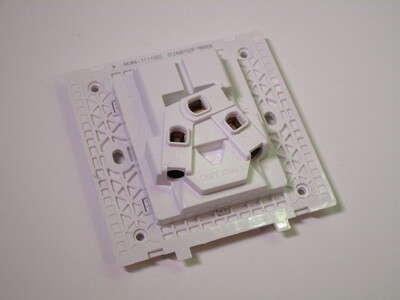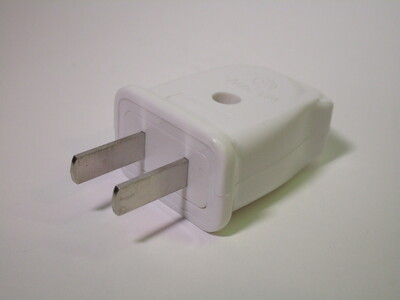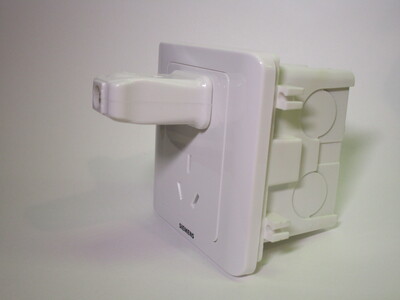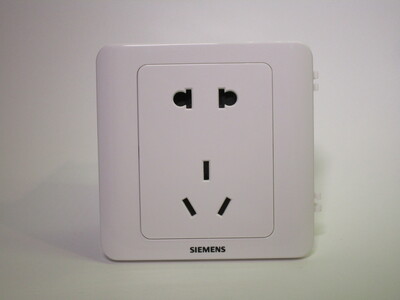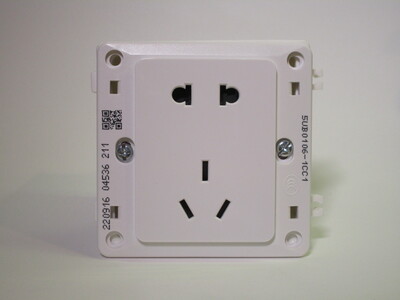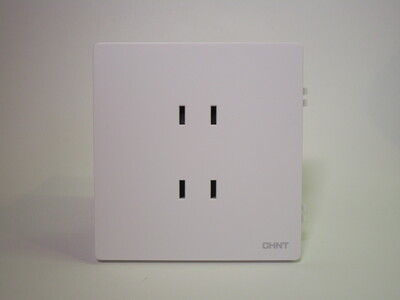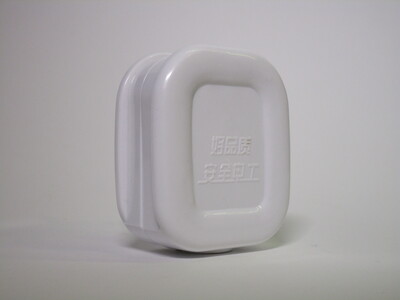Plugs and sockets in China
China (PRC), as is sometimes seen in other Asian countries, has adopted multiple plug standards domestically. Earthed appliances use Australian-style plugs, which for this reason are sometimes called "Australasian"; non-earthed devices tend to use plugs with round pins or flat prong (US style). While these standards are entirely incompatible with one another, sockets tend to allow connection both of earthed and non-earthed appliances.
Australasian plugs are typically found only on earthed appliances; furthermore, they're the only type to be polarised, meaning line and neutral cannot be reversed. While polarisation remains the same as Aus/NZ (unlike in Argentina), there are other significant differences compared to ordinary Australian plugs: the plug orientation is inverted, with the earth pin up. Plugs don't feature sleeved pins, but newer sockets do often feature safety shutters.
North American-style plugs with two flat prongs are typically found on non-earthed devices; plugs with two round pins such as Europlugs or similar are less common and not always compatible with all sockets. Compared to traditional American plugs, these have two main differences: they usually are entirely solid, without the two small holes normally found on American two-prong plugs, and they're always non-polarised. In fact, sockets often only accept non-polarised plugs.
It should be noted that Hong Kong and Macao are an exception, as for historical reasons they have adopted British BS 1363 plugs which remain in use to this day. Additionally, despite the use of American-style 2-prong plugs (type A), the Chinese grid runs at 220V 50Hz.
Chint power socket
Rating: 10A 250V
As mentioned, Chinese power sockets typically feature both Australasian and American 2-prong outlets. Such is the case on this example from Chint, a popular manufacturer of electrical items in China. It has a modern design and appearance and an overall high-quality feeling. Both parts of the socket feature shutters.
The three-prong outlet's shutters, as is often common in China, are the "UK style" ones which activate on the insertion of the earth pin of a 3-prong plug. Therefore 2-prong Australasian style plugs are entirely incompatible with this socket.
The front faceplate covers the entire socket, making the overall look seamless without any gaps. Once it's removed, the device can be mounted using the provided screws. The wall boxes used in China are identical to UK single-gang ones.
Non-earthed plug
Rating: 10A 250V
This is a typical non-earthed rewireable plug, using American style flat pins. As is common with Chinese plugs of this type, it's not polarised (if it were it wouldn't fit in most sockets) and doesn't have the two small holes on the pins.
Siemens power socket
Rating: 10A 250V
Compared to the Chint socket seen before this one has a more "classical" styling, with a slightly curved glossy faceplate. Aside from that, the main difference with this outlet is the addition of compatibility with round-pin plugs such as Europlugs. Both 2- and 3-prong outlets feature shutters; as before, the latter's mechanism is activated by the insertion of the earth pin.
It's interesting to note that unlike the Chint socket this one's faceplate is more traditional, in the sense that it only covers the outside edge rather than the whole front.
Dual non-earthed socket
Rating: 10A 250V
Non-earthed power sockets are also available: this one from Chint is part of the same model lineup as the one shown earlier, but rather than having one non-earthed and one earthed socket it has two non-earthed ones, of the US-only non-polarised type.
Presumably sockets of this sort are especially useful for plugging in several electronic devices, which often do not need an earth connection - similarly to the Europlug sockets from Europe. However, they ideally should always be accompanied by a nearby earthed socket to avoid people using adaptors to bypass the earth and connect an earthed appliance to these sockets.
16A earthed plug
Rating: 16A 250V
Aside from the usual 10A earthed plug, 16A and 20A versions are also available, with bigger pins to handle the extra current. Interestingly, these are different from the Australian 15A and 20A plugs, making them potentially incompatible.
Socket with light switch
Rating: 10A 250V (socket), 16AX 250V (switch)
This socket by Chint is virtually identical to the 2- and 3-prong one seen initially, save for the presence of a light switch. The switch is long but very thin, spanning the entire height of the socket, and is positioned on the left hand side.
The terminals on the back are the usual screw type. The switch itself is wired entirely separately from the outlets, with its own two terminals. It's only a one way switch, meaning it can only control a light fixture from one point, but there is a provision for an additional terminal for other models.


